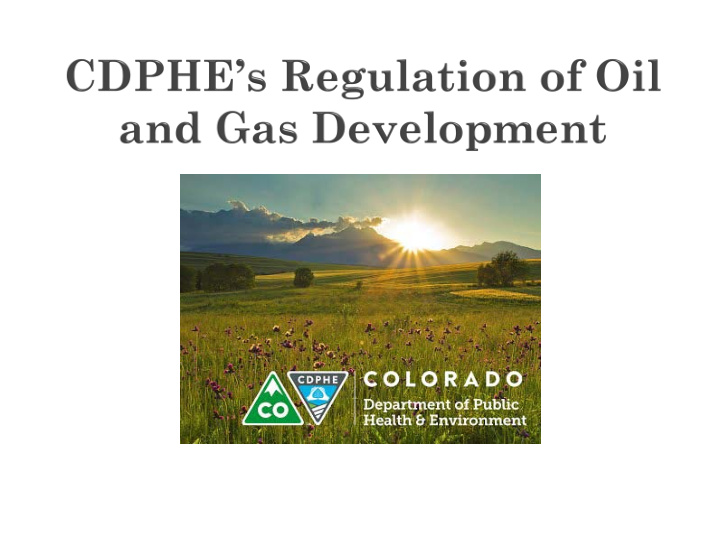



In 1989 S.B. 181 was amended to define the responsibilities of state agencies to implement water quality protection of state waters. ◦ COGCC Responsibilities ◦ Water Quality Control Commission Role ◦ Water Quality Control Division Role 2
The Federal Clean Air Act (CAA) is a comprehensive law that regulates air emissions. Under the act, EPA sets health-based standards for certain air pollutants. EPA has delegated the Air Pollution Control Division (APCD) to implement the CAA within Colorado.
The APCD develops air quality regulations, implements the air quality monitoring program, conducts inspections and enforces air quality regulations. Colorado has 60 air quality monitoring sites throughout the state to monitor air quality and identify emerging trends.
“Continuous” data posted hourly on APCD Technical Services website and uploaded to EPA’s AIRNow website ◦ http://www.colorado.gov/airquality/ ◦ http://airnow.gov/ Forecasting performed daily and posted on APCD Technical Services website ◦ Summaries available at www.epa.gov/airdata/
Colorado currently meets all federal air quality standards statewide, with the exception of ozone in the Denver/North Front Range area. This will change when EPA comes out with a new Ozone standard lower than the current standard of 75 ppb (annual fourth-highest daily maximum 8-hr concentration, averaged over 3 years.)
Air quality monitoring at well sites are not the best use of resources. ◦ Locating a monitor depends heavily on the wind direction, which is always changing. ◦ There are no specific air quality standards for VOC or methane. ◦ Natural background level of methane is 1.8 ppm, so what level above background constitutes a problem? ◦ High winds create more air dispersion and in low winds pollutants may rise and transport over a monitor.
General Requirements Any naturally occurring unrefined petroleum liquid collection, storage, processing and handling operation shall be designed, operated and maintained so as to minimize leakage of VOCs and other hydrocarbons to the atmosphere to the extent reasonably practicable.
A comprehensive leak detection and repair program; Statewide control and inspection requirements for storage tanks; Statewide requirements for auto-igniters and low-bleed pneumatics;
Requirements to route gas to a pipeline or control device from first date of production; Stringent emission control requirements for glycol dehydrators; and Use of best management practices to minimize emissions from well maintenance activities.
The potential health impacts of air pollution depend upon several factors, such as the amount of pollutants in the air, how the pollutants move and transform in the environment (including influences of meteorology and topography) and the length of time people may be exposed to air pollution.
Methane ◦ No health effects from low level exposures Particulate matter ◦ Increases in respiratory and cardiovascular disease Ozone ◦ Can cause breathing difficulties and premature disease
Operations with potential for short-term exposures that may cause irritation symptoms Reports of irritation and skin symptoms in residents in close proximity Risk assessments ◦ Suggest slightly elevated cancer risk ◦ Possibility for respiratory/neurological effects from shorter exposures for those closer and exposed during development activities
Emissions and Dispersion study conducted by Garfield County via a contract with Colorado State University in Garfield County (Project timeline 2013 – 2015) Emissions and Dispersion study conducted by CDPHE via a contract with Colorado State University in Weld County (Project timeline 7/2013 – 6/2016) Risk assessments not funded
Extensive measurement technology ◦ Real-time ◦ Canister ◦ Tracer gas Data can be generalized to receptor position and type of oil and gas process (Source: Collett Lab, Colorado State University)
Better exposure data (CSU Studies) ◦ New risk assessment studies ◦ Better registry-based epidemiological studies Collaboration with other states ◦ Best practices ◦ Shared experiences Other possibilities? ◦ Systematic collection of health reports? ◦ Population-based surveys?
Recommend
More recommend